Trilobite Book Reviews
Fossils from Morocco Vol. 1
By Patrice LeBrun
This dual-language (French & English), hard cover, coffee table-style tome attempts to do the near-impossible; to sort through the dizzying array of trilobites emerging from the fossil-rich soils of Morocco and place them in some sort of chronological and geological order. With literally hundreds of species running the gamut from Lower Cambrian to Middle Devonian, this is truly an imposing task. And though Fossils from Morocco is thoroughly researched, cleverly planned, and efficiently executed, the resulting 300-page volume presents some mixed results.
Paramount among the “problems” is that too many of the presented specimens appear to have been enhanced more than trilobites in a comprehensive work such as this should be. On occasion, author Patrice LeBrun mentions that a particular photographed trilobite may have been altered post-discovery, and he presents an entire chapter discussing the legendary faux trilobites of North Africa. But too often the reader is left wondering if what they are looking at is totally real… or the result of some Moroccan artisan’s creative hand.
The other somewhat disconcerting element that runs throughout Fossils from Morocco – which, by the way, also briefly delves into the nation’s ammonite and Devonian fish reserves -- is the printing itself; the script-style font occasionally utilized, as well as the continually diminutive size of the type face, too often serve to negate many of the insightful points that LeBrun puts forth. While the overall look of the presentation is outstanding, a magnifying glass is a veritable necessity merely to view certain trilobite names.
Still, many of the photos presented here are of unique and special trilobites (drawn from a variety of private collections), and virtually every species recognized from the nation’s bountiful Paleozoic lagerstatte is featured at one point or another. Indeed, Fossils from Morocco, goes a long way towards clearing up the oft-muddled mess that, in the minds of too many, has come to define the Moroccan trilobite scene. LeBrun’s writing style is efficient, if occasionally a tad dry, perhaps a reflection of the French-to-English translations that fill every page. Yet his insights on over a dozen different Devonian sites alone allow the reader a much-needed perspective on both the differences and similarities that exist within these trilobite-bearing locales.
While the definitive book on Moroccan trilobites is yet to be written, this volume goes a long way towards closing a huge chasm that has long existed within the trilobite world. Despite its hefty price, it is a worthy (and much needed) addition to trilobite research… and should be a welcomed addition to the shelves of serious trilobite collectors from London to Los Angeles.
Trilobites of the British Isles, by Dr. Robert Kennedy and Sinclair Stammers
Any number of nations may lay claim to possessing the world’s richest trilobite heritage. At various times over the last two centuries, the United States, Russia, Canada, Morocco and the Czech Republic have each -- through word, deed or action -- contributed mightily to the ever-expanding legacy of these primeval creatures. However, when all is said-and-done, perhaps no country on Earth can match Great Britain in terms of either its ground-breaking academic pursuit of the subject, or its available trilobite resources. From the Cambrian material that dots the coastlines of both Scotland and Wales, to the Carboniferous specimens that derive from the English Midlands, the undeniable fact is that the British Isles pack an impressive Paleozoic punch into a relatively diminutive territorial domain.
The broad swath of trilobite material that graces this European kingdom is celebrated in the softcover work succinctly titled Trilobites of the British Isles. Written by noted trilobite collector/researcher Dr. Robert Kennedy, with the able assistance of photographer Sinclair Stammers, this highly informative, richly illustrated, 384-page volume goes to laudatory lengths in its attempts to present as comprehensive a work as paleontologically possible.
To achieve his goal of updating more than 300 years of British trilobite tradition and research, Kennedy has not only focused upon presenting the stellar arthropod attractions housed within his own world-class collection, but has also delved deep into the resources provided by his fellow British trilobite enthusiasts. He has also thoroughly scoured the trilobite repositories stored in many of his homeland’s leading institutions, including London’s legendary Natural History Museum, the Oxford University Museum of Natural History, and the University of Birmingham’s Lapworth Museum. There are even photos of a few noteworthy specimens that have been pulled directly from the pages of this very AMNH trilobite website… with our permission, of course!
The eye-popping Ordovician species from Shropshire, England, and Girvan, Scotland – including Selenopeltis inermis, Dionide turnbulli, Pricyclopyge binodosa, Primaspis girvanensis and Toxochasmops bisseti -- are provided ample space to shine, often in full-page close-ups. Yet, arguably, the visual stars of this volume are the amazing array of Silurian trilobites hailing from the environs in and around the town of Dudley. That is especially true of the beautifully preserved trilobites from Wren’s Nest – including such legendary species as Cheirurus centralis and Calymene blumenbachii – which in their fossilized perfection seem to defy the 420 million years that have passed since they last inhabited the ancient seas.
In all, nearly 800 color photos are included here, featuring 343 trilobite species, many representing the finest complete examples ever found. The net-effect serves to create what may well be the ultimate compendium of British trilobite types. Amid a welcomed wave of trilobite-oriented books that have emerged in recent years, Trilobites of the British Isles stands out as a wonderfully researched and thoughtfully presented volume designed to appeal equally to the professional scientists and amateur enthusiasts among us.
------------------------------------------------------------------------------------------------------------------------
Furongian (Upper Cambrian) Trilobites from the McKay Group, Bull River Valley, Southeastern BC, Canada by Brian Chatterton & Stacey Gibb
Over the last 15 years, a veritable bonanza of beautifully preserved Upper Cambrian trilobites has emerged upon the world stage, all drawn from a single paleontological hotbed located in a remote corner of southeastern British Columbia. The trilobites found at this site not far from the town of Cranbrook are distinctively preserved in a thick, black calcite, and are often discovered in hard mudstone concretions which often capture in rich detail both the positive and negative impressions of these 490 million year old arthropods.
This notable McKay Group lagerstatte found within the rugged Kootenay Mountains is some 20 million years more recent than the province’s famed Middle Cambrian outcrop, the Burgess Shale – located 190 miles to the north. Yet the startling abundance and diversity of the Cranbrook material, which in recent years has been successfully collected on a commercial level, has caught the attention of both enthusiasts and academics around the globe.
Indeed, the content of the area’s bountiful trilobite fauna has now been scientifically studied and identified, with the results being published in the new volume, Furongian (Upper Cambrian) Trilobites from the McKay Group, Bull River Valley, Southeastern BC, Canada. Written by Brian Chatterton and Stacey Gibb, both affiliated with the University of Alberta, Edmonton, this 271 page monograph offers detailed descriptions of 59 trilobite species in 31 genera – including 22 previously unidentified species and 5 new genera -- featuring such distinctive trilo-types as Orygmaspis (Parabolinoides) jenkensi, Irvingella dawnae and Olenaspella chrisnewi.
Written in both English and French, this publication represents the culmination of a decade-long study, during which time hundreds of complete McKay Group trilobite specimens have been unearthed, prepared and carefully annotated. All the trilobites featured in this volume were extracted from 11 closely aligned sites which together form a series of narrow sedimentary bands which crisscross the exposure. Unlike many academic trilobite papers which rely almost exclusively on partial, surface-collected material as the basis for study, the specimens featured here are uniformly complete and well represented in 84 detailed photographic plates.
Among the more intriguing observations offered by Chatterton and Gibb within this volume is that the studied McKay Group fauna displays notable affinities to material found in similarly-aged outcrops in both South China and Korea. Such findings suggest to the authors that back in the Upper Cambrian, the location of the McKay Group – adjacent to the supercontinent of Laurentia – lay in proximity to these other fossil-bearing locales… which today find themselves thousands of miles apart.
------------------------------------------------------------------------------------------------------------------------
Exceptional Cambrian Fossils From Utah
A Window Into The Age of Trilobites by Richard A Robison, Loren E. Babcock and Val G. Gunther
When it comes to Cambrian trilobites, there is perhaps no more prolific and scientifically significant locale in the entire United States than Utah. It is there that layer upon layer of sedimentary rock-- ranging in age from the Middle Cambrian Spence Shale to the Late Cambrian Weeks Formation-- have yielded one of the richest troves of Paleozoic treasures found anywhere on Earth. Whether it is the common Elrathia kingi (which have been found by the thousands in commercial quarries) or the exotic Olenoides vali (of which perhaps only a handful of complete specimens are known), the incredibly abundant strata of the 45th State has provided anyone interested in trilobites with a unique portal through which to view a mind-boggling array of 500 million year-old arthropods.
Now, with the release of the richly illustrated book Exceptional Cambrian Fossils From Utah: A Window Into The Age of Trilobites, a proper forum has at last been provided for these amazingly ancient creatures. Written by paleontologists Richard A Robison (University of Kansas) and Loren E. Babcock (Ohio State University) along with renowned amateur collector Val G. Gunther (whose family enjoys an unmatched 60-year history of collecting Utah trilobites), this 97 page soft-cover volume presents enough scientific “meat” to satisfy even the most scholarly enthusiast. A detailed, alphabetically listed description of each featured trilobite species is offered, along with information highlighting the key Cambrian formations and outcrops throughout the state. Yet for many, it will be the “flash” provided by hundreds of full-color photographic plates-- some presenting recently discovered or newly described species-- that will provide the most compelling reason to purchase this book.
Occasionally the volume's content wanders away from its core subject to present a variety of other Cambrian fossils found throughout Utah …including an impressive array of soft-bodied critters strikingly similar to those found in Canada's famed Burgess Shale. Rather than being a distraction, however, these diversions-- which do take up almost half of the book's pages-- only add another element of wonder to the area's incredibly diversified fauna. But there is no denying that at its heart this book is about trilobites, trilobites and more trilobites, with such noteworthy species as Modocia typicalis, Glossopleura bion and Zacanthoides grabaui all being provided the proper text & photo outlet through which to showcase their stunning natural beauty.
Whether you live thousands of miles from the state's fossil-rich terrain, or have been climbing through the Drum Mountains since you were a kid, Exceptional Cambrian Fossils From Utah: A Window Into The Age of Trilobites seems destined to quickly establish itself as a “go-to” volume in anyone's fossil library. While a number of recent trilobite-related books have tackled the subject from a worldwide perspective, this tome stays contentedly within its own well-defined borders with uniformly satisfying results.
------------------------------------------------------------------------------------------------------------------------
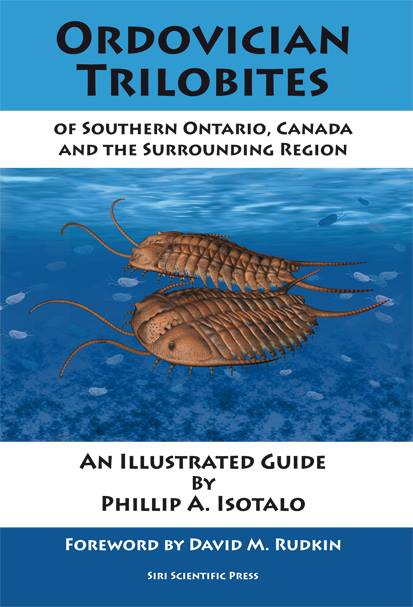
Ordovician Trilobites Of Southern Ontario, Canada and the Surrounding Region - An Illustrated Guide by Phillip A. Isotalo
There are literally dozens of “legendary” trilobite locales dotted across the face of Planet Earth. The fact is that just about anywhere you travel-- from the Cambrian Wheeler Shale of Utah, to the Silurian outcrops of Dudley, England, to the rich Devonian fauna of North Africa-- with a little effort you can encounter a famous fossil outcrop. Certainly the 450 million year old Ordovician strata of Ontario, Canada, ranks high on this noble list, having provided the trilobite community during two centuries of exploration and excavation with some of the most impressive, beautiful and scientifically significant “bugs” of all-time.
In his new Illustrated Guide, Ordovician Trilobites Of Southern Ontario, Canada and the Surrounding Region, author Phillip A. Isotalo presents all of the best known-- as well as many of the often overlooked-- species from that area in a comprehensive manner designed to appeal to the hearts and minds of trilobite enthusiasts everywhere. Featuring an array of detailed color photos and comprehensive descriptions of such notable trilo types as Gabriceraurus dentatus, Isotelus gigas and Hemiarges paulianus, this volume captures the incredible diversity of species that appear within the various formations of the region.
For good measure, this soft-cover book also throws in efficient pictorial visits to surrounding strata in New York State (including the famed Beecher Beds and Walcott-Rust quarry), with the apparent intent to compare and contrast material from similar locales. Previous volumes have attempted to traverse similar paleontological turf, most notably the Royal Ontario Museum's time-tested Fossils of Ontario Part 1: The Trilobites. This new effort, however, pushes previous boundaries by presenting more detailed photographs of far more aesthetic specimens while significantly updating the known database regarding formations, stratigraphy and fossil distribution.
With an entertaining and informative “foreward” penned by David Rudkin of the ROM, Ordovician Trilobites Of Southern Ontario, Canada and the Surrounding Region tackles its chosen subject with intelligence, insight and at times a surprising degree of ingenuity-- including detailed illustrations that add a valuable dimension to the photographic presentation. Though this may not rank among the great scholarly dissertations on trilobites, it makes minimal attempts to be more than it is… a fantastic and much-needed reference volume for both the avid collector and the professional paleontologist.
------------------------------------------------------------------------------------------------------------------------
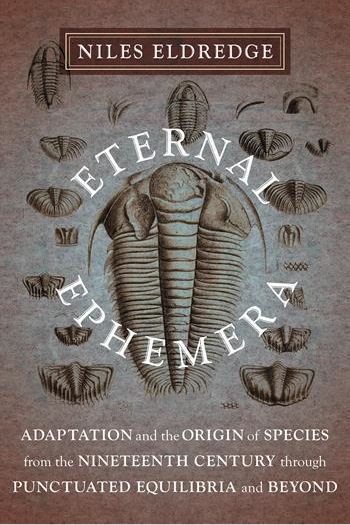
Eternal Ephemera: Adaptation and the Origin of Species from the Nineteenth Century Through Punctuated Equilibria and Beyond by Niles Eldredge
Niles Eldredge ranks among the towering figures of contemporary scientific thought. His 1972 work with Stephen Jay Gould on the theory of Punctuated Equilibria helped change the way in which evolution was viewed in perhaps the most revolutionary manner since Darwin himself first put quill to paper. A former Curator of Invertebrate Paleontology at New York's famed American Museum of Natural History, Eldredge has remained at the hub of evolutionary discussion and debate (yes, unfortunately, there is still debate about evolution), a topic he presents with aplomb, innovation and insight throughout his latest book, Eternal Ephemera: Adaptation and the Origin of Species from the Nineteenth Century Through Punctuated Equilibria and Beyond.
Throughout this substantial yet eminently readable tome, Eldredge explores the manner in which our views regarding evolution have changed over the last two centuries. Launching his effort with examinations of famed French naturalist Jean-Baptiste Lamarck and Italian geologist Giambattista Broochi-- both of whose work was later presented to a young Charles Darwin-- Eldredge conveys both the brilliance of these early thinkers as well as the restrictive intellectual environment in which they initially launched their work.
Considering Eldredge's long-standing fascination with Darwin (he has served as curator for the touring Darwin exhibition which has been viewed by over a million visitors during the last decade), it is no surprise that the legendary English naturalist stands as a centerpiece of Eternal Ephemera. Darwin's groundbreaking work is discussed and placed in historical perspective, while serving as the springboard for the analysis of more contemporary evolutionary efforts by the likes of Ernst Mayer, George Gaylord Simpson, and yes, even a young Eldredge & Gould.
There is a great deal for the trilobite enthusiast to grasp within the pages of Eternal Ephemera: Adaptation and the Origin of Species from the Nineteenth Century Through Punctuated Equilibria and Beyond. Not only does a Joachim Barrande trilobite print adorn the book's front cover, but much of Eldredge's original groundbreaking work on Punctuated Equilibria centered on his study of the trilobite Phacops rana, a subject he addresses in impressive detail. There is no question that anyone interested in trilobites, or evolutionary thought in general, will find this book to be a welcomed-- and often referenced-- addition to their science library. Colorfully written with obvious passion and knowledge, Eternal Ephemera provides one man's unmatched insight into one of the most enduring scientific issues of all-time.
------------------------------------------------------------------------------------------------------------------------
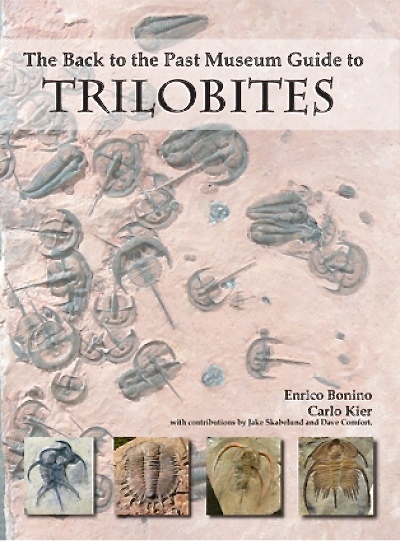
THE BACK TO THE PAST MUSEUM GUIDE TO TRILOBITES by Enrico Bonino and Carlo Kier
For many years there has been a pressing need within the fossil community for a “fan friendly” book about trilobites. Oh sure, we've all enjoyed our various Nature Guides and Picture Books which served to first introduce many of us to the wonderful world of paleontology. But when it came to our favorite arthropods, the available literature tended to drift in the direction of desert-dry treatises or doctorate-detailed scientific papers.
Thus, the emergence of The Back to the Past Museum Guide to Trilobites has been such a welcome addition to the available resources on the subject. Beautifully designed and lavishly illustrated, this near-500 page volume is a joy to peruse… though its sheer size and weight makes it a challenge to hold and navigate. Divided into sections detailing subjects such as Trilobite Morphology and Classification before getting “down to business” with over 300 full-color photo plates presenting eye-popping specimens ranging from Cambrian to Carboniferous, this edition is geared to make every museum curator take notice and every trilobite collector drool with envy. Delving deeply into famed trilobite deposits in China, Italy, Bolivia, Morocco and the United Sates (among others), this is one guide truly world-wide in its scope.
Both Bonino and Kier (the latter of whom runs the Back to the Past Museum as part of his hotel in Cancun, Mexico) approach their subject from an avid enthusiast's perspective. Neither shy away, however, from presenting the latest scientific theories concerning the composition of trilobite exoskeletons and eyes as well as the detailed examination of trilobite soft tissue. But their primary passion is clearly on assembling and then disseminating high-res photos of some of the most unusual and intriguing trilobite specimens ever seen. From super-rare Bristolia insolens to spectacular Belenopyge balliviani there is little more that any dedicated follower of trilobite fashion could ask for. And perhaps the best news for trilo-fans everywhere is that the editors behind this Guide to Trilobites are currently in the process of assembling material for a second volume which promises to kick everyone's fossil fever up another notch.
------------------------------------------------------------------------------------------------------------------------
 TRILOBITES OF NEW YORK: AN ILLUSTRATED GUIDE by Thomas E. Whiteley, Gerald J. Kloc and Carlton E. Brett
TRILOBITES OF NEW YORK: AN ILLUSTRATED GUIDE by Thomas E. Whiteley, Gerald J. Kloc and Carlton E. Brett
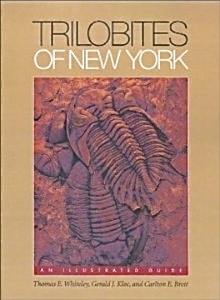
Even for the most fossil-obsessed among us, it seems safe to say that when images of New York come to mind, rarely are those mental pictures of trilobites. If any book has a fighting chance of changing that attitude, however, it's Trilobites of New York: An Illustrated Guide. Throughout this voluminous tome, the book's three authors present the diverse and beautiful trilobite fauna of the Empire State with an unmistakable passion and a welcomed degree of perception. The state's rich paleontological history-- including the likes of Charles Walcott himself- is also featured right along with detailed descriptions of key fossil localities and revealing photos of the unquestioned stars of the “show”… the state's dizzying array of trilobites.
Ranging from NY's sporadic but significant Cambrian layers, and running right up through its amazingly abundant Devonian holdings (with special attention focused on both the state's legendary Silurian-age Rochester Shale deposits and Ordovician Rust/Walcott quarry), the book's authors present a cogent and at times compelling tale both in depth-defying words and eye-catching black and white photos. There are enough stunning images featured throughout this volume to satisfy the most demanding trilobite-o-phile, with the entire second half of the book dedicated to 175 plates presented not only in chronological, time-period progression, but also by order and species. Such an endeavor was clearly a daunting task to undertake, with many of the featured specimens being shown in print for the first time. This was a project approached with a winning combination of insight, enthusiasm and intellect.
There is something for everyone in Trilobites of New York, from the novice beginner to the most acclaimed museum curator. Quite simply, this is a “must-have” book for anyone interested in trilobites. Indeed, it is work that may allow some of us to think of Arctinurus boltoni or Odontocephalus aegeria rather than the Statue of Liberty, the American Museum of Natural History or even Niagara Falls, when images of New York spring to mind.
------------------------------------------------------------------------------------------------------------------------
 THE TRILOBITE BOOK by Ricardo Levi-Setti
THE TRILOBITE BOOK by Ricardo Levi-Setti
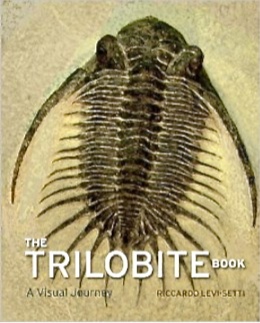
When Ricardo Levi-Setti's book Trilobites was first released more than two decades ago, it served to transform the world's understanding and appreciation of these famed arthropods. With a detailed text that was still accessible to the layman, and hundreds of spectacular black & white photographs of specimens from throughout the world-- drawn from both museum holdings and private collections-- the book stood as the foundation of a true trilobite renaissance. By introducing scientists and amateur enthusiasts to the then-just-burgeoning material emerging from Morocco and Russia as well as featuring world-class specimens from legendary locales throughout North America and Europe, Trilobites was a tome truly revolutionary in nature.
Much has changed both in the world of trilobites and the world in general since that volume's 1993 release. Improved preparation techniques have made spectacular trilobites relatively common occurrences, while the Internet has made the acquisition of such specimens available to just about anyone with sufficient interest and the funds to afford them. Thus the appearance of Levi-Setti's latest effort, The Trilobite Book, comes across as somewhat anticlimactic.
This time the text is held to a minimum so that the focus can be on presenting the trilobites in their full-color glory. While the book does feature material from such varied paleontological ports as the Czech Republic, Great Britain and North Africa, and some of the planet's leading scientific institutions contribute images of their prized specimens, unfortunately the “wow” factor employed so effectively in Levi-Setti's previous work, is here conspicuously absent. Many of the specimens now figured- especially the renowned Pardoxides from Canada's Manuels River- have been previously seen in Levi-Setti's earlier books, while a simple click on the Internet will instantly produce even more breathtaking examples of exotic trilobites.
If you own Levi-Setti's seminal 1993 work, or even his earlier 1979 effort, then you will probably want to add The Trilobite Book to your fossil bookshelf. But if it is to serve as your starting point for trilobite-related material, there are better, more exciting places to begin.
------------------------------------------------------------------------------------------------------------------------
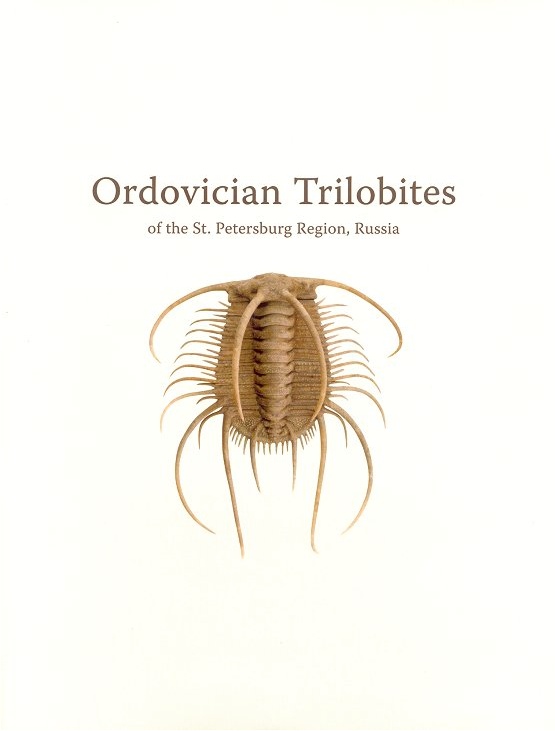
Ordovician Trilobites of the St. Petersburg Region by V. Klikushin, A. Evdokimov, A. Pilipyuk
For decades prior to the fall of communism in the late '80s, rumors of stupendous Russian fossil reserves had been reported by paleontologists lucky enough to have visited behind the Iron Curtain. Tightly sequestered rooms in major Soviet museums were practically bursting at the seams with material collected everywhere from the flat tundra of Siberia to the hilly Permian cliffs of Estonia.
Those western scientists who had been invited on rare Russian field expeditions between the years of 1917 and 1989 often returned with glowing reports of strata bulging with ammonites, trilobites and vertebrate material of all sorts and ages. Yet, with most Soviet scientists having their interests focused upon more pressing matters than the collection of fossils, and with the notorious KGB as well as the Soviet government carefully regulating the export of their nation's "natural resources", few if any of these Eastern European treasures ever found their way out of their homeland and onto the open market.
By the early '90s, however, all that had begun to change. At major fossil and mineral shows such as those held annually at Tucson and Munich, magnificent and unique Russian fossil specimens began to surface. And of all the Russian fossil material that suddenly began appearing in western markets at that time, little drew as much attention from the both the scientific and collecting community as the beautifully bizarre assortment of trilobites that were being pulled out of the hillsides along the Wolchow Valley near St. Petersburg. With their shiny caramel-colored exoskeleton contrasting dramatically against a light tan matrix, and incredible three-dimensional preservation, these ancient arthropods (400-450 million years old) soon became the rage of fossil collectors everywhere. Now, for the first time, a definitive work has been published on the Ordovician trilobites of Russia, and it may well rank among the most compelling and fascinating books ever put together on the subject of trilobites.
Featuring 544 pages, filled with nearly 700 beautiful color photos of over 200 different trilobite species,Ordovician Trilobites of the St. Petersburg Region, Russia, is a feast for both the eyes and mind. This coffee-table sized volume, which clocks in at an impressive 5+ pounds in weight, represents a decade's worth of cumulative work by the book's three authors. From the most common Asaphid to the rarest Lichid, they're all here in their surprisingly spinose glory... complete specimens that stand in sharp contrast to the often fragmentary material so often featured in scientific literature. Indeed, this is a work that will invariably prove useful to both the trilobite-obsessed collector as well as the most high-minded academic. Aside from the "classic" (and soon to be completely revised) 1959 treatise on trilobites, Ordovician Trilobites of the St. Petersburg Region, Russia stands among the must-have volumes for everyone even remotely interested in trilobites.
------------------------------------------------------------------------------------------------------------------------
 TRILOBITES OF THE WORLD: AN ATLAS OF 1000 PHOTOGRAPHS by Pete Lawrance and Sinclair Stammers
TRILOBITES OF THE WORLD: AN ATLAS OF 1000 PHOTOGRAPHS by Pete Lawrance and Sinclair Stammers
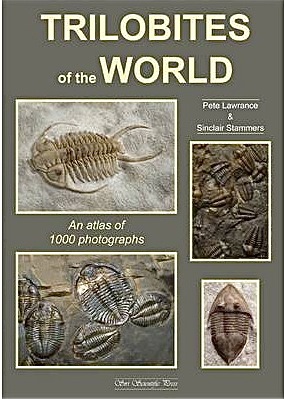
In recent days it seems there has been a veritable (and welcome) avalanche of new books focused on presenting both the inherent beauty and quirky charms of trilobites. Among the latest is Trilobites of the World: An Atlas of 1000 Photographs, a pleasing and easily digestible display of information and photos that has been carefully assembled by authors Pete Lawrance and Sinclair Stammers. Featuring an impressive array of 1000 photos- which depict over 700 different species in full color- this is a well-designed volume that deftly covers the nearly 300 million year reign of the world's favorite fossilized arthropod.
With Lawrance a leading collector, and Stammers a renowned photographer, the pair make a dynamic duo when it comes to gathering together and presenting specimens from the four corners of the globe. Highlights include beautiful and unusual trilobites from Great Britain (no great surprise considering both of the authors' British roots) as well as recently uncovered material from such paleontological hotbeds as Morocco and Russia. Also featured are eye-catching examples of unusual species from Bolivia, Germany and China. While one could nit-pick and state that the display of North American trilobites featured here is generally less than awe-inspiring, even at its weakest point this “atlas” never fails to be informative and highly entertaining.
The bottom line is that amid the recent flurry of trilo-books, this one will serve as a solid addition to anyone's collection due to both its comprehensive nature and easy-to-handle size. While it may lack the scientific detail found in some volumes, and miss the wow-factor specimens featured in others, Trilobites of the World earns its rightful place among important books for the true trilobite enthusiast.